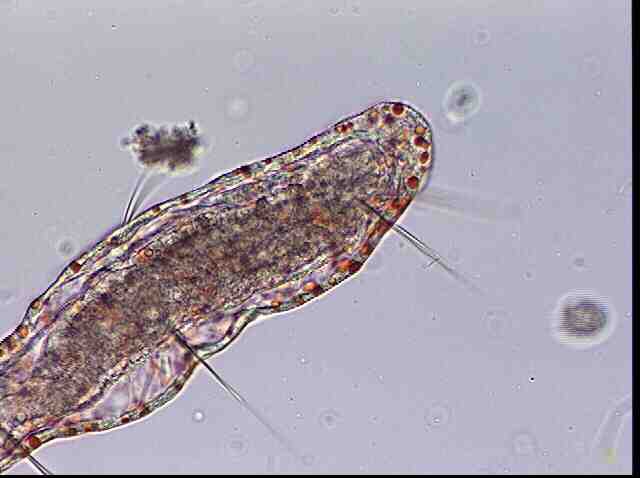Biological Products:
Bioaugmentation products for Wastewater applications in Papermills, Refineries, Chemical, Tanneries, Municipalities, Textiles, Steel, Agriculture, Animal feedlot, Gun Powder plant, Food and Beverage- Dairy Products, Orange Juice factory, Wineries, Cookie factory, Vegetable processing plant, Meat packing, Barbecue Restaurant, Aquaculture, Ornamental Ponds for algae control, CAFO, Nursing homes, Military, Campgrounds, Universities, Regulatory agencies
Lab Services:
Filamentous Identification Lab Service. One reason to identify filaments is to determine the filaments characteristics and then determine the type present. If the type is found out, a root cause can usually be associated with a particular filament. If the cause is known, then a correction can be made to alleviate problems. Chlorination is only a quick fix. Without process changes, filaments will grow back after chlorination. Wastewater Biomass Analyses and Cooling Tower Analyses also available
Training Materials:
Training is an integral part of any job. Not everyone is at the same level of training. Many people want beginning concepts and basics. Some need technical information or troubleshooting. Some want equipment, technology or process information. We have developed a full set of Basic training, Advanced training, Filamentous Identification the Easy Way as well as custom training CD's Manuals. We also provide hands-on training classes and soon will have an Online "E-University".
Audits and Consulting:
At Environmental Leverage® Inc., we have a team of experienced individuals who come into your plant with a fresh pair of eyes. The system is checked from influent to effluent. System optimization, equipment efficiency and operational excellence are key components explored. Key Benefits Equipment efficiency Total Cost of Operation reductions Reliability and safety An onsite audit is conducted to examine system parameters, process controls, and current monitor and control procedures. A physical walk-through is conducted, process flow diagrams are examined, previous design criteria are examined and current standard operating procedures are evaluated along with data logs.
|
Worms
What's New!
We now have a brand new "Higher Life Form videos" in our Training CD list. Check out our new Wastewater Training Materials. We are also in the process of developing new courses for our ""Online University" in order to meet the needs of our global customers that cannot travel to our public classes. WastewaterElearning.com/Elearning
We hope you like the new look of our Higher Life form Identification Pages If you would like more information on bacteria, filaments or higher life forms, you might want to consider purchasing our Wastewater Microbiology Training materials. We also have our lab that can perform a Wastewater Biomass lab analyses of your own MLSS for more information
worms
Identification Free-living nematodes are non-segmented, terrestrial macroinvertebrates (no backbone or invertebrate). They may be saprozoic, saprophytic, or coprozoic. They often they may look segmented due to the thickening of the cuticle or epidermis. Their bodies are cylindrical with tapering ends. Nematodes range in size from 0.5 to 3.0 mm in length to 0.02 to 0.05 mm in width. Aquatic earthworms have setae along the body which allows them to tunnel through the floc particles, ingesting chunks of bacterial floc. They can be very common in old activated sludge.
Nematodes also secrete a sticky substance in order to anchor themselves to a substrate (media) or floc particles so that they can feed without interference by currents or turbulence. A lack of nematode activity or dead and hollow nematodes can be one of the bio-indicators of a toxic condition that may be developing in the treatment process.
Additional Information: Free-living nematodes include eel worms, nemas, roundworms, and threadworms. Some types of free-living nematodes commonly found in wastewater are Butlerius, Caenorhabditis, and Rhabditis. Bristle worm or Aeolosoma sp. are usually long segmented worms with bright pink spots. The pink spots on a bristle worm are easy to detect without any staining. Bristle worms can turn an entire clarifier pink. They usually indicate the presence of high nitrates. Bristle worms have many internal organs and bristle like setae for locomotion. They reproduce by budding at a particular segment.
Environment They are found in many different types of wastewater. Nematodes are often observed in higher MCRT systems or where the sludge is older. They thrive in aerobic wastewater treatment processes when the D.O. concentrations are high and bacterial food is abundant. They are present in large numbers in secondary wastewater effluent, trickling bio-filters or rotating biological contactors (RBC's) where an older biofilm develops.
They are usually the last to come ( as far as age) and the first to go( as far as increases in toxicity or BOD loading) from an "indicator organism" standpoint. They can indicate a system with a very old sludge age, high MLSS, low F/M ratio or high MCRT. Their burrowing action permits oxygen diffusion to the floc structures which promotes microbial activity. They crop the bacterial population and recycle nutrients. Bristle worms also tolerate low oxygen conditions. They are found in older activated sludge ages. They are usually indicative of high nitrates present in the water. Some plants use rotifers and worms as an indicator to when to increase wasting since it means their sludge is getting older.
How to find them: Microscopic examination of a wet mount. Some of the larger worms can be seen at 40-100x and 200x. Nematodes crawl upon floc particles and move in whip-like fashion when in the free-swimming mode.
It depends upon what the rest of the biomass looks like. Typically the
presence of worms indicates an older sludge age with low loading of food
vs. the amount of biomass available to stabilize the organics. Worms
indicate a relatively healthy, older wastewater treatment system, no toxicity, progressing along
in a sludge age towards stable to endogenous age. If mixed in with the right
amount of stalked ciliates, and a few free swimming ciliates and rotifers, you are probably doing
very well.
It may mean the sludge is older if the floc is golden to dark brown, firm and compact. Usually you can expect very few solids in the effluent and slightly lower BOD levels than if free swimming ciliates are present in significant numbers. If you push the sludge age too old, though beware, the floc will start to break apart and water quality will deteriorate. Ashing on the clarifier is a sign that the sludge is getting older or running out of air. Another symptom will be very dark brown to black centers in the floc structure.
If you have once through lagoons, you may find many worms, as well as many different types in the same sample. Wastewater lagoons differ from activated sludge and the types of higher life forms may vary depending upon the holding time of the lagoon and if a very large wastewater lagoon, different sections will have different stages of higher life forms.
Daily microscopic analyses at your wastewater treatment plant is helpful in documenting where you are today, where you have changed since the previous day and how to react to changes proactively as opposed to when they have become critical!
What should I do if there is a
significant change in my higher life forms and all of a sudden there is an
increase in worms?
You might want to increase your wasting levels at your wastewater
treatment plant.
More to come soon! For more information on Higher Life Form Identification More photos to come. . .
If you need more information on our Filamentous Identification the Easy Way Training CD or on Internet training on Filamentous bacteria, causes and controls. How and why on Wastewater Biomass Analyses
|

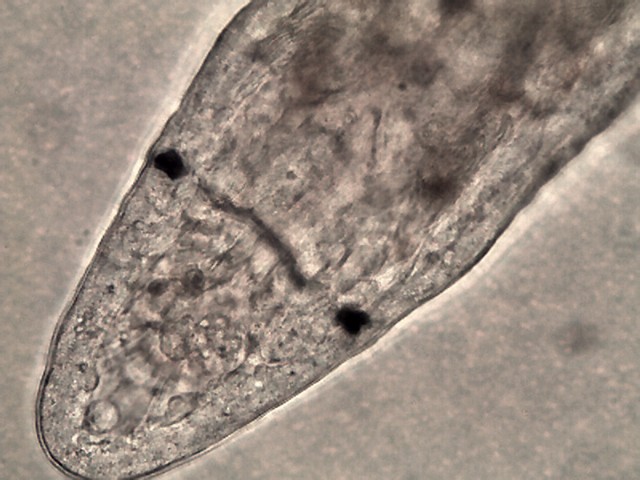 When
trying to determine microscopic species in your wastewater treatment plant, stick to the basics, and focus on the causes
and controls of the higher life forms present. The main point of any
wastewater biomass identification is not
to get a PhD, but to fix your plant!
When
trying to determine microscopic species in your wastewater treatment plant, stick to the basics, and focus on the causes
and controls of the higher life forms present. The main point of any
wastewater biomass identification is not
to get a PhD, but to fix your plant!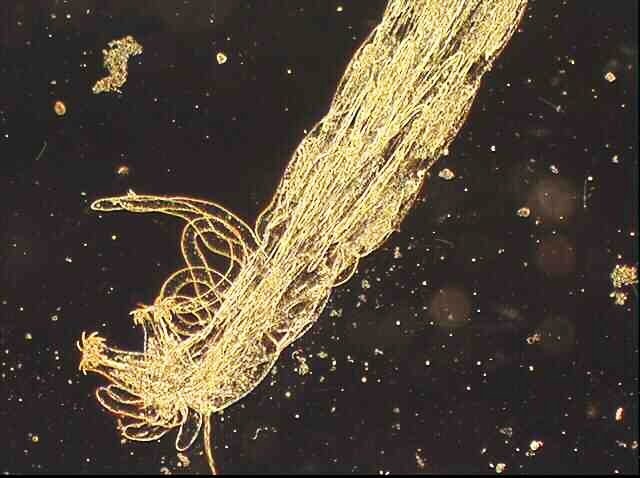
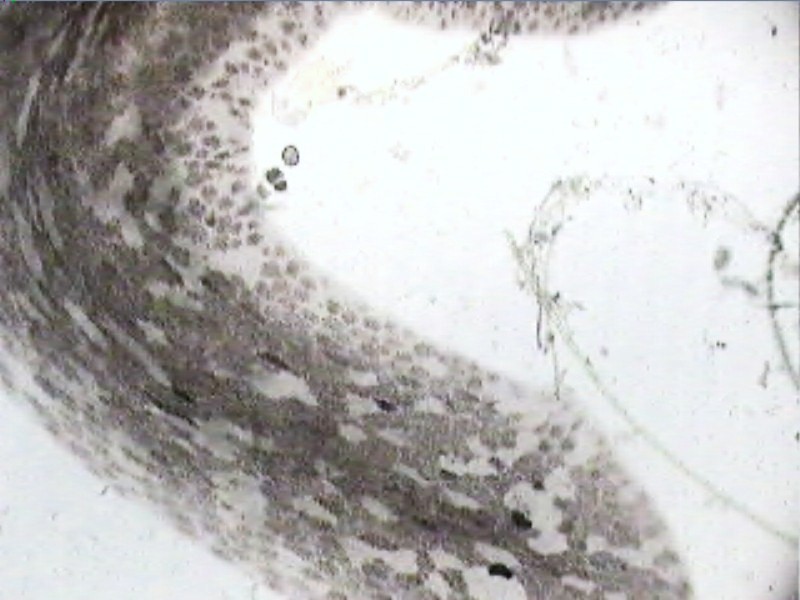 What
does it mean when I see an increase in worms in my system?
What
does it mean when I see an increase in worms in my system? 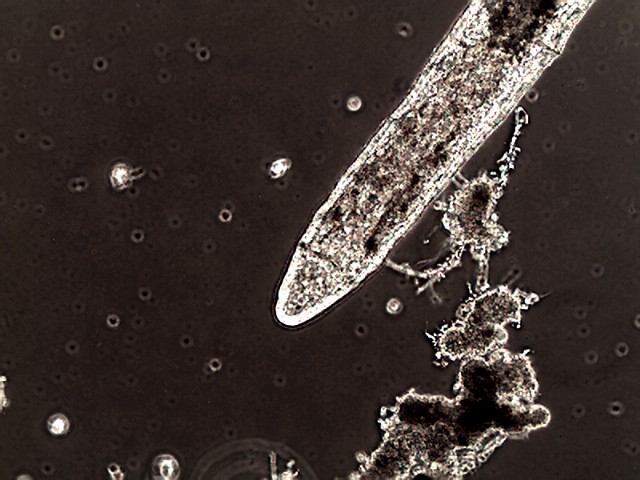 They
reproduce by budding at a particular segment.
They
reproduce by budding at a particular segment.